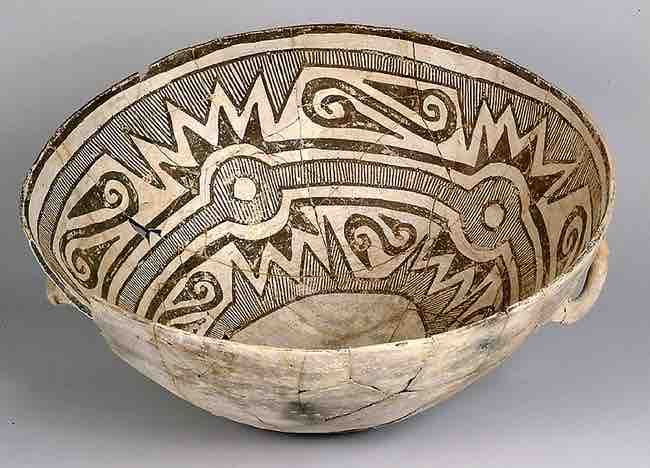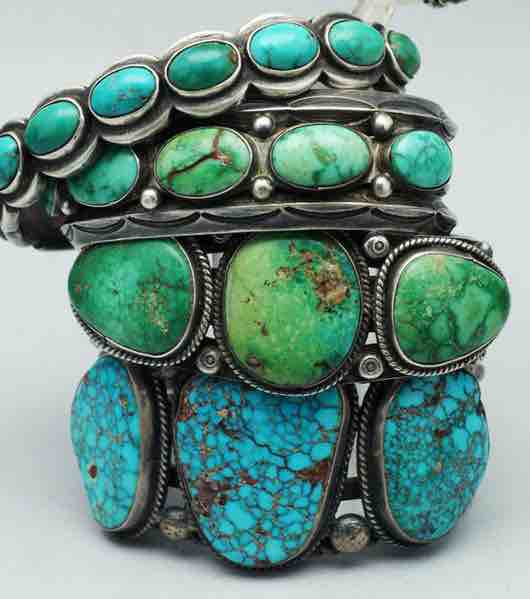Overview: The Art of the Southwest
Prior to European invasion of North America, the region of the Southwest was dominated by the Pueblo, Navajo, Apache, Hopi, and Zuni peoples, among others. These peoples were rich in culture and history, creating magnificent works of pottery, jewelry, painting, weaving, and architecture. The Anasazi, or Ancestral Pueblo (1000 BCE–700 CE), are the ancestors of today's Pueblo tribes. Their culture formed in the American southwest, after the cultivation of corn was introduced from Mexico around 1200 BCE. People of this region developed an agrarian lifestyle, cultivating food, storage gourds, and cotton with irrigation or xeriscaping techniques. They lived in sedentary towns, so pottery, used to store water and grain, was ubiquitous.
Pottery
For hundreds of years, the Pueblo created utilitarian grayware and black-on-white pottery, incorporating reds and oranges toward the end of their era in the 13th century. Designs were painted on the exterior of black-on-white pottery and the interior of bowls, primarily with geometric shapes or representations of people, animals, and birds. Pottery making became an art form for individuals who specialized in distinctive styles made for trade. The Hopi were known for creating ollas, dough bowls, and food bowls of different sizes for daily use; they also made more elaborate ceremonial mugs, jugs, ladles, seed jars, and vessels for ritual use. These finer works were usually finished with polished surfaces and decorated with black painted designs.

Pottery of the Pueblo
Ceramic bowl from Chaco Canyon in New Mexico, Pueblo III phase.
Jewelry and Silversmithing
Jewelry and other ornaments were made by the Pueblo using shells and stones bartered from the coasts of Mexico and California. Within the region, turquoise, soapstone, and lignite were attained through trade. Just as pottery from this period has received world-wide recognition, work inlaid with shell and turquoise from this period was noteworthy for its artistry and sophisticated inlay techniques.

Old and new Navajo bracelets
The Navajo are well-known today for their use of turquoise in jewelry.
In the 1850s, the Navajos adopted silversmithing from the Mexicans. Atsidi Sani (Old Smith) was the first Navajo silversmith, and the technology quickly spread to surrounding tribes. Today, thousands of artists produce silver jewelry using turquoise. Their hallmark jewelry piece known as the squash blossom necklace first appeared in the 1880s; while turquoise had been part of jewelry for centuries, Navajo artists did not use inlay techniques to insert turquoise into silver designs until the late 19th century. Sikyatata became the first Hopi silversmith in 1898, and Hopi are renowned for their overlay silver work and cottonwood carvings. Zuni artists are admired for their cluster work jewelry showcasing turquoise designs, as well as for their elaborate, pictorial stone inlay in silver.
The centuries-old art of lapidary, preserved by clan and family tradition, remains an important element of design. These works of art are commonly decorated with stone on stone mosaic inlay, channel inlay, cluster work, petite point, needle point, and natural cut or smoothed and polished cabochons fashioned from shells, coral, semi-precious gems, and precious gems; as with other art forms, blue or green turquoise is the most common and recognizable material used.
Navajo Sandpainting
Sandpainting is an aspect of Navajo healing ceremonies that inspired an art form. It involves the pouring of colored sands, powdered pigments from minerals or crystals, and pigments from other natural or synthetic sources onto a surface to make a fixed or unfixed kind of painting. In the sandpainting of southwestern Navajo, the Medicine Man (or Hatałii) paints loosely upon the ground of a hogan, where the ceremony takes place, or on a buckskin or cloth tarpaulin, by letting the colored sands flow through his fingers. The colors for the painting are usually accomplished with naturally colored sand, crushed gypsum (white), yellow ochre, red sandstone, charcoal, and a mixture of charcoal and gypsum (blue). Brown can be made by mixing red and black; red and white make pink. Other coloring agents include corn meal, flower pollen, or powdered roots and bark.

Navajo sandpainting
One of the four elaborate dry-paintings or sand altars employed in the rites of the Mountain Chant, a Navaho medicine ceremony of nine days' duration.
Weaving
Navajos came to the southwest with their own weaving traditions; however they learned to weave on upright looms from Pueblos and wove blankets that were eagerly collected by Great Basin and Plains tribes in the 18th and 19th centuries. After the introduction of the railroad in the 1880s, imported blankets became plentiful and inexpensive, so Navajo weavers switched to producing rugs for trade for an increasingly non-Native audience. Rail service also brought in Germantown wool from Philadelphia, a kind of commercially dyed wool, which greatly expanded the weavers' color palettes. Some early European-American invaders moved in and set up trading posts, often buying Navajo rugs by the pound and selling them back east by the bale.
Architecture
The Anasazi culture is perhaps best known for the stone and adobe dwellings built along cliff walls, particularly during the Pueblo II (900-1150 CE) and Pueblo III (1150-1350 CE) eras. Adobe structures are constructed with bricks created from sand, clay, and water, with some fibrous or organic material; they were then shaped using frames and dried in the sun. These villages, called pueblos by Spanish settlers, were often only accessible by rope or rock climbing. One of the most elaborate and largest ancient settlements is Chaco Canyon in New Mexico, which includes 15 major complexes of sandstone and timber connected by a network of roads.
In the Southwestern United States, numerous pictographs and petroglyphs were created. The creations of the Fremont culture, the Anasazi, and later tribes can be seen at present day Buckhorn Draw Pictograph Panel and Horseshoe Canyon, among other sites. Petroglyphs by these and the Mogollon culture's artists are represented in Dinosaur National Monument and at Newspaper Rock.